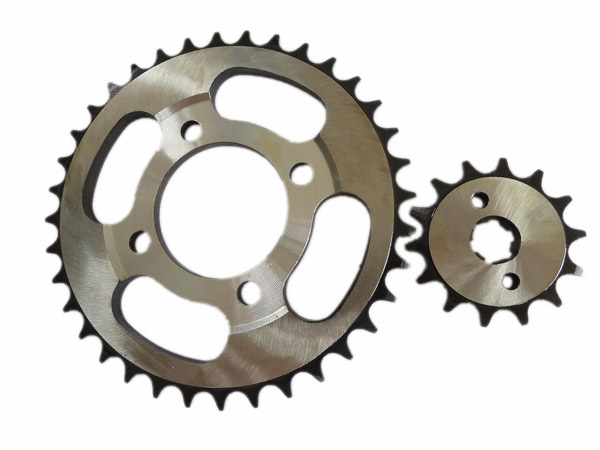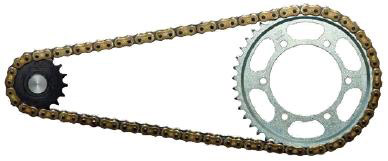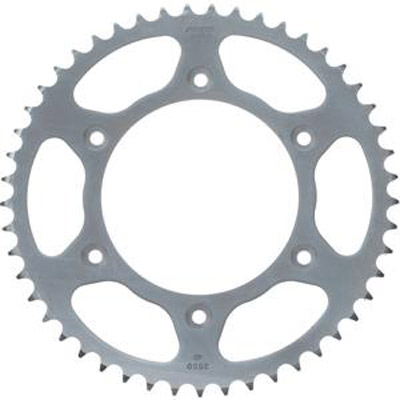 You must have heard about terms like sprockets, sprocketing, gears and gearing etc. These are integral parts of any motorcycle engine and play significant role in performance delivery of your bike. Today we will try to explain not only the significance of these important parts in your motorbike but implications of altering these parts in the performance of bike also.
You must have heard about terms like sprockets, sprocketing, gears and gearing etc. These are integral parts of any motorcycle engine and play significant role in performance delivery of your bike. Today we will try to explain not only the significance of these important parts in your motorbike but implications of altering these parts in the performance of bike also. What Is Sprocket?
Firstly what is a sprocket? A sprocket or sprocket-wheel is a profiled wheel with teeth, cogs, or even sprockets that mesh with a chain, track or other perforated or indented material.
What Is Sprocketing?
Sprocketing means changing the front & rear sprocket sizes to affect gearing. It's one of the simplest and easiest modifications. The basic info says that:
- Bigger rear sprocket or smaller front sprocket, results in gearing biased towards acceleration, with some lag in top speed.
- Smaller rear sprocket or bigger front sprocket, results in gearing biased towards top speed, with some lag in acceleration.
What Is Gearing?
Gearing is a measure of all the components that determine the rate at which an engine's crankshaft's revolutions are transmitted, into the vehicle's speed. It comes from the word "gears" which are rotating cogs, which decide what speed the machine picks up, at a particular rpm.
Means To Alter Gearing:
- Altering Sprocket size
- Changing rear tyre size
- Gearbox modification
- Clutch drag, etc.
**Note: Gearing is NOT affected by: Weight/ load change (pillion, etc.), front tyre change, free flow air filters/ power mods, etc.
 Final Gearing Value:
Final Gearing Value: The sizes of front and rear sprocket (measured in "no. of teeth" the sprockets have) determines the final gearing. It is calculated by Rear Sprocket Teeth divided by Front sprocket Teeth. For example; Pulsar 180 UG4 has a 14 front and 39 rear setup. So, its stock final gearing ratio is 39/14 which is equal to 2.786.
Final gearing is for comparison between different sprocket combinations, this way:
45/15= 3.000 (Let's call this "Setup X")
44/14= 3.143 (Under gearing, compared to "Setup X", means more acceleration)
39/14= 2.786 (Over gearing, compared to "Setup X", means more top speed)
45/15= 3.000 (Let's call this "Setup X")
44/14= 3.143 (Under gearing, compared to "Setup X", means more acceleration)
39/14= 2.786 (Over gearing, compared to "Setup X", means more top speed)
The higher Final Gearing value signifies moving gearing towards acceleration (short gearing), and vice versa. So, when changing both sprockets from stock, the new gearing value should be calculated to determine which way you're going with gearing.
The Taller gearing/over gearing results in better highway mileage, and Short gearing/under gearing results in less highway mileage. This is due to the fact, that in taller gearing, the machine travels longer distance for a particular engine speed (rpm), and vice versa.
But if you overgear too much, you might need a very long stretch to achieve a good top speed, or you might not achieve it at all. So, for a stock bike, a gearing change should be well within 10% of the stock final gearing at maximum, that's it!
 Affect Of Altering Rear Tyre Size On Gearing:
Affect Of Altering Rear Tyre Size On Gearing: Rear Tyre change (size) may affect overall gearing, if the profile (height) is affected due to this change. A higher profile increases gearing, while a lower profile decreases it. A tyre with size 120/70 has a normal height of (120mm x 70%) which is 84mm. But, the broadness of the tyre rim can change the "final height".
A broader rim gives less tyre height, as tyre is made of rubber, and it expands when fitted over the broader rim, causing lesser ride height & lower gearing. And of course, vice versa too. For example; if you fit the R15 rear tyre on your Pulsars, you might not change gearing at all, because although the R15 tyre is of lower height, but the Pulsar rim is narrower than R15's, and a narrow rim raises the ride height.
**Note: Front tyre size change doesn't affect gearing, although it may contribute to a different ride height, weight and different speeds on the speedometer.
We can find final gearing ratio by using any combination of sprockets by using (Rear no. of teeth/Front no. of teeth) formula. But what if we change a lot of things like, both sprockets, rear tyres, Primary Ratio, rear rim, etc.? Fear not, there is a solution. You can find out all about the gearing even before trying it out. Plus it has stock info on gearing of many bikes. You can use the below website for calculating gearing by entering everything that affects gearing: gearingcommander.com
Finally I would like to thank Mr. Samarth Singh who has helped us with the better understanding of this topic.
You may also like our article " How to Increase Performance Of 4-stroke Motorcycles"
By: Rakesh Gowda











